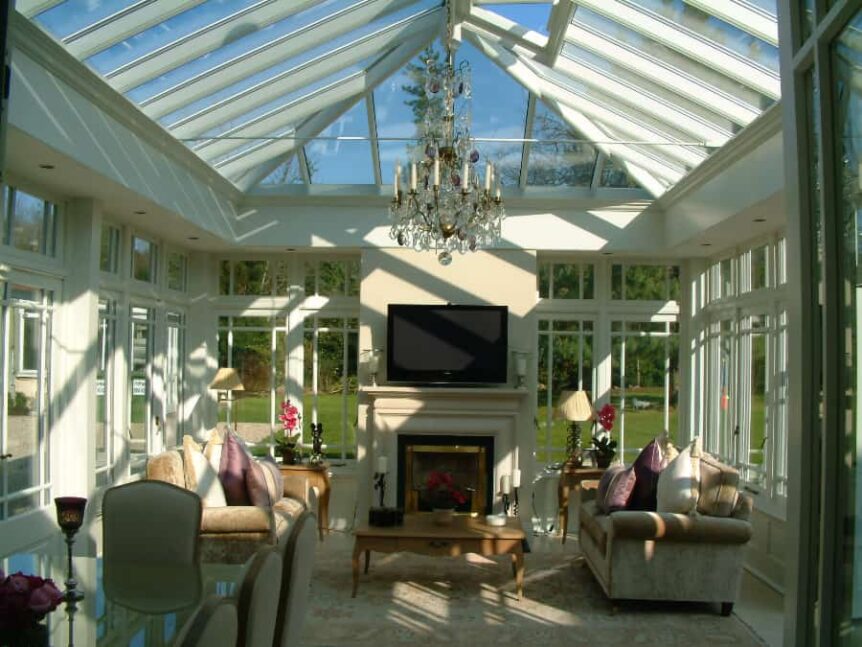Brrr… we’re back to colder weather conditions. Glazed extensions are often believed to be unsuitable when the mercury drops: stereotypically too hot in the summer and too cold in the winter. However, due to years of technological advancements, these concerns are a thing of the past for bespoke conservatory and orangery owners as there are a variety of methods available for both cooling and heating, no matter what the conditions are like outside.
Cooling an orangery or conservatory
One of the most effective methods of cooling a conservatory is to ensure that adequate roof vents have been installed. Having a roof vent enables warmer air to escape as it rises and creates a flow of air through the room , lowering the temperature inside. By opting for electric roof vents with thermostatic control and rain sensors, ventilation can also be automated so that the vents will open when the weather is warm and dry, and close upon sensing rainfall. This will allow the conservatory to maintain a comfortable temperature at all times, without the need for human intervention – it’s also reassuring for homeowners to know that they’ll never come home to puddles after an unexpected summer shower!
Another method of cooling an orangery or conservatory is to install solar reflective glass, a type of glazing that reflects heat from the sun, reducing the heat that can develop due to solar gain. Ideally, the decision to install solar reflective glass would be made at the time of building the extension, but it is possible to replace the glazing further down the line if this is something that has been overlooked.
Many older conservatories are adorned with blinds both within the roof space and on the glazed walls but in more modern conservatories, this is purely an aesthetic choice. The materials and design of new bespoke conservatories are more than capable of providing adequate climate control and so blinds are not essential.
Warming an orangery or conservatory
With temperatures having dropped around the UK and many locations seeing their first glimpse of snow this winter, maintaining temperatures may be more of a pressing issue at present.
So what are the options to heat the room?
As with any extension, the homeowner may choose to specify radiators for internal walls. Obviously these new extensions are often fairly voluminous spaces so it’s vitally important to speak to a heating specialist to specify radiators of the correct size.
However, designer radiators come in all shapes and sizes so rather than select a traditional style, homeowners may prefer something more in keeping with the planned decor, or may like to use the walls wisely by specifying vertical radiators or even a bench radiator which serves a dual purpose.
Underfloor heating is the most popular choice of heating for orangery and conservatory owners. This can be electric or water-based but either way, heat and humidity are evenly distributed throughout the room which creates a comfortable temperature. As the new glazed extension and the adjacent rooms are often knocked through, it can be beneficial to have the underfloor heating on a separate zone so that it can be more easily controlled – particularly if it is in use all day when the rest of the property does not require warmth.
Log burners and fires are not always front of mind when planning a new orangery or conservatory but not only do they provide a source of heat, they also provide a feature or focal point in the large space. It may be that one of the knocked through rooms has a chimney that can be put to good use, if not, a stand-alone log burner can be specified. Similarly to choosing radiators, homeowners need to get the correct-sized log burner or fire for the room otherwise it will simply be a pretty addition rather than making any functional difference to the temperature.
Various Building Regulations apply to installing a log burner or fire so this is something that should be discussed with the orangery designer and a specialist installer.
Once a room is warm, the homeowner will rightly want to have peace of mind that this heat will not escape. The design, manufacture and material choice of a bespoke glazed extensions will ensure that the new room is often the most cosy in a property. Walls will be insulated and glass will be double or triple glazed to the highest standard with gas-filled cavities to enable maximum thermal optimisation.
Gain expert advice
Before committing to a new glazed extension, ensure the designer you choose takes these considerations into account to ensure the new room can be fully enjoyed all year round.

